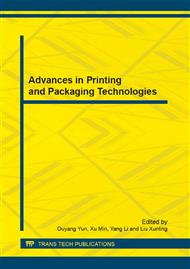p.532
p.537
p.543
p.547
p.551
p.557
p.561
p.567
p.572
Study on an Aliphatic Polyurethane Laminating Adhesive Based on Castor Oil
Abstract:
The first component of the Polyurethane adhesive was prepared with polyester polyol, polyether polyol ,castor oil and isophorone diisocyanate. And this component was mixed with the castor oil and its modified production to prepare a two-component solvent-free aliphatic polyurethane laminating adhesive. In this study, the influences of the copolymerization ratio of polyester/ether on viscosity, heat resistance, adhesion strength and boiling resistance were studied, as well as influences of castor oil and its modified production on curing speed and adhesion strength. The results showed that when proportion of polyether diol was 25% and castor oil was 50% of the total hydroxyl content of first component, the PU adhesive with lower viscosity, better reactivity and enhanced boiling resistance would be achieved. And with an appropriate amount of derivatives castor oil in second component, the curing speed and adhesion strength of the PU adhesive were significantly improved.
Info:
Periodical:
Pages:
551-556
Citation:
Online since:
December 2012
Authors:
Price:
Сopyright:
© 2013 Trans Tech Publications Ltd. All Rights Reserved
Share:
Citation:


